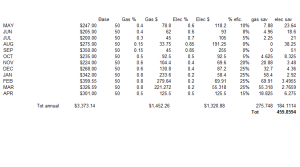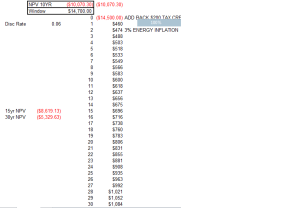We’re putting in new windows. Our home is about 15 years old and the original windows are the typical lousy builder’s grade from that period. Many have since cracked or have condensation between the panes and the manufacturer is out of business so no replacements under warranty. I know in the summer we’re losing money on cooling costs and in the winter, there’s a ton of money going out the windows – literally. I can feel and hear wind whistling through some of the windows when it’s real windy and at night I can feel the draft. That being said, for such a large undertaking like a full window replacement, you’ve gotta run the numbers, right?
ROI on Window Replacement
The reality is that even though the windows are terrible and new windows would be much more efficient, I will never make my money back on this “investment”. Let’s be honest. Most people want new stuff and justify it to themselves by claiming they’re saving all this money on energy. Buying a new Tesla? You’ll never break even if you drive it for 100 years vs just buying a small, cheap fuel-efficient conventional vehicle. Putting solar panels on your roof in the Northeast? Doubt it. We have a family member that paid thousands of dollars to convert their house from electric to gas – and they’re moving within a couple years. Horrible, total waste of money.
So, let me show you my assumptions and calculated ROI (return on investment) and NPV (net present value) – both are negative.
My energy bills aren’t really that bad to begin with. It’s a bit of a hassle to figure out what’s what because there are all kinds of fixed costs in the bill like conversion charges, etc. which probably sum to ~$50 a month no matter what my usage is. So, if I strip those out, and then ignored the electric it takes to run our pool each summer (see full detailing of all contractor issues you contend with when putting in a new pool), I had to make a few assumptions on how to guess what my energy savings will be. I don’t believe when some salesman says, “your energy costs will drop 30% when you put in my windows”. That’s a load of garbage and more than one have told me that. First off, we don’t even use heating or cooling in March, April, May, September or October. So that’s more than a third of the year that the windows won’t save me a dime. Next, there are many days in the winter and summer that we don’t require heating or cooling either. So, in order to actually hit a net 30% savings on an annual bill, the windows would have to save me over 50% when I’m “in-season”. That’s an outrageous assumption, even for older, lousy windows. So, I worked backwards by looking at my actual month gas and electric charges and then assigning a percent savings to each month depending on whether it’s heating or cooling (thus applying savings to gas or electric portion of the bill).
In essence, using my conservative, yet realistic assumptions, I came up with only about $460 per year in actual energy savings.
Table (click to enlarge)

Now, my quote for 22 windows plus 2 special windows with half-moon things over them was for $14,700. I will be getting Simmonton 5500 class at about $600/window installed (since the special windows were a bit more). In case you’re wondering, I went with middle-high grade windows as opposed to the cheapest window. These have the bells and whistles like Low-E, argon filled double-hung, good warranties on both parts and labor, etc. I also got several quotes from both regional window specialists, contractors and the typical Home Depot/Lowes. This quote was second lowest and the windows seem better than what the big boxes were offering like Reliabuilt by Atrium and some others. We had one offer at $30,000 which was absurd. I’m going to write a separate post outlining all the companies, the quotes and how I’m negotiating this installer lower so make sure to subscribe here if interested in the followup.
Actual ROI and NPV Calculations for Window Installations
People use the term ROI without really considering the proper context. I already know it’s a negative return, so I’ll look at a few useful concepts. The first is payback period which is simply the cost divided by the annual savings to tell me when I’ll make my money back – but the problem is it doesn’t account for present value/future value. Either way, if inflation is low and your discount rate isn’t too far off from inflation, it’s not a horrible measure to use. For this case, the payback period is $14,500 (since I get that lame $200 tax deduction) divided by $460 = 31.5 years. That’s longer than a mortgage on a home. And it doesn’t account for the fact that the savings out in 2044 will be worth much less to me than that money now. So, payback period is horrible.
Most importantly though is the Net Present Value/Net Present Cost. That is a measure we should always use, but people are lazy and don’t want to use the NPV function in excel or understand the Present Value of Money. It’s all explained in that post, so check it out for formulas and real-life examples. Anyway, using the assumptions of a future 3% inflation rate on energy costs (if we are only so lucky) and a discount rate of 6% I could reasonably earn in equities over a lifetime, I come up with the following negative NPVs:
Table (click to enlarge)
- 10 year: -$10,070
- 15 year: -$8,619
- 30 year: -$5,329
Most people consider a 10 year NPV to be suitable for their purposes since conditions change, people move, etc. at least once a decade. But just to illustrate that windows aren’t a great “investment” even over the life of a full mortgage, the 30 year NPV is also negative. Of course, these numbers would look more favorable if I felt I could only earn 2% a year for life or if energy costs were to skyrocket. But I’m basing my assumptions on recent history which is the best I have to go on.
If you read the earlier article on present value of money and NPV still doesn’t make sense to you, think of it like this. By executing this purchase, even considering the future energy savings I’ll derive, it’s the same as basically paying between $5,000 and $10,000 for new windows from an aesthetic and comfort standpoint (possibly a slightly better selling point in the future as well). That number’s less than $14,500, but I don’t make my money back by any means.
If It’s Such a Bad Investment?
You’re probably used to seeing glowing reviews about all the great money moves people make with their home improvements and investments. Here, I’ve pointed out that this makes no sense on a purely financial basis. So, why would I go ahead with this purchase? Well, we’d established a couple years ago that we weren’t moving into the big McMansion, but would instead stay in our house, invest some money here and keep our fixed costs lower and live a simpler life. So, the fact that our windows stink and we’re here for at least 20 years means we are DEFINITELY going to end up replacing them at some point. It might have been in 3 years, might have been in 5. But the bottom line is that windows is a category we had agreed to tackle years ago and now we have the funds to do it. Knowing that, why wait for 5 more years living with lousy windows and energy losses if I could just get on with it now? Some things I’m putting off, like replacing the HVAC unit or the roof. I will wait for the unit to die and then use our emergency fund to quickly replace it. The roof has probably 5 more years in it. But the windows were something we could do now that would benefit us instantly. That’s my justification and I think for most people, that’s the reality for their window replacement project as well – but they use faulty assumptions to justify it on a financial basis.
Why Didn’t I Install My Own Windows?
That’s another question you’re probably asking. If you’ve ever known anyone that’s had trouble with their windows, you’ll know why. You end up with mold, leaks into your home and all sorts of other problems. Caulk cracks over time and I’ve never put a window in myself. I also don’t get a warranty on my own work. I’ll leave this all to the professionals and by competitively bidding it out, I’m fairly confident I got the best deal possible under today’s market conditions.
I’d be interested to hear your thoughts on this analysis and any home window upgrade experiences you’ve had.


{ 6 comments… read them below or add one }
I need to do this too but just can’t pull the trigger. We should have gotten this done when there were some tax incentives to do so. Now it feels even more expensive since we waited. I was well aware of the negative NPV, but thanks for laying it out so cleanly.
The only thing you didn’t mention is security. To me our old contractor windows feel pretty insecure. Most of them are stuck now due to settling and being painted so perhaps that’s an offset, but I have to think that newer windows might provide a better sense of security.
I am kicking myself a bit for not either doing HVAC or windows when I could have gotten the full $1500, but I do wonder if contractors were somewhat jacking up their prices to reflect the known tax incentive. i.e. the day it expired, did their quotes all of the sudden become a bit cheaper? After all, many consumers make their decisions based on the big picture, tax breaks included.
I’m replacing windows, the old ones are shot. I guess it comes down to the house being a liability not an asset and what conditions you can live with. Look at the money you put into vehicle upkeep, you’ll never get it back but that’s not the point.
If they’re shot, then it’s a necessity. Ours are crappy, but I guess something I should have put into the equation which would have made it appear a bit more favorable is what it would cost to replace the ones now on an individual basis which are cracked/cloudy. I suppose if I spent $1500 on those and compared that to the outlay for all new, then the NPV looks that much better.
One plus for changing out the old windows for new is that the new windows are easier to clean. I have old window that have a storm window but they are in great condition. When I have to clean them I have a double job, first I clean the primary window and then I have to clean the storm window. Also I have to use a ladder to get at the outside of the primary window. With the new replacement windows you can tilt them in and do not have to use a ladder. I’m still not going to replace my windows. Let the next owner do it.
It is impressive the various innovations they have come up with over the years. Better cleaning, security measures, the screens fix themselves, etc.